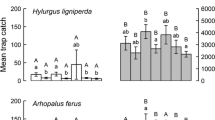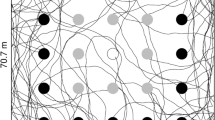Abstract
The catches of bark beetles (Coleoptera: Scolytidae) were compared between attractive traps releasing semiochemicals and passive traps (cylindrical sticky screens hung, at 10 heights of 0.7–11.5 m, on poles). A central attractive-trap pole was surrounded by three passive-trap poles spaced 50 or 100 m away at the apices of an equilateral triangle. The catches ofTomicus piniperda and other scolytid species on the attractive-trap pole baited with host monoterpenes, or the catches ofIps typographus attracted to synthetic pheromone, were compared to passive trap catches in a Scots pine forest or in a Norway spruce clear-cut, respectively. Information about flight height distributions of the above scolytid species, andHylurgops palliatus, Cryphalus abietis, Pityogenes chalcographus, P. quadridens, P. bidentatus, andTrypodendron domesticum were obtained on the passive and attractive trap poles. A new method is presented for determining the densities of flying insects based on the passive trap's dimensions and catch, duration of test, and speed of insect. Also, a novel concept, the effective attraction radius (EAR), is presented for comparing attractants of species, which is independent of insect density, locality, or duration of test. The EAR is obtained by the ratio of attractive and passive trap catches and the dimensions of the passive trap, and thus should correlate positively with the strength of the attractant and the distance of attraction. EARs are determined from catch data ofT. piniperda andI. typographus as well as from the data of previous investigations on the same or other bark beetles.
Similar content being viewed by others
References
Baker, T.C., andRoelofs, W.L. 1981. Initiation and termination of oriental fruit moth male response to pheromone concentration in the field.Environ. Entomol. 10:211–218.
Borden, J.H., Hunt, D.W.A., Miller, D.R., andSlessor, K.N. 1986. Orientation in forest Coleoptera: An uncertain outcome of responses by individual beetles to variable stimuli, pp. 97–109,in T.L. Payne, M.C. Birch, and C.E.J. Kennedy (eds.). Mechanisms in Insect Olfaction. Clarendon Press, Oxford.
Bossert, W.H., andWilson, E.O. 1963. The analysis of olfactory communication among animals.J. Theor. Biol. 5:443–469.
Burnell, D.G. 1973. A dispersal-aggregation model for mountain pine beetle in lodgepole pine stands.Res. Popul. Ecol. 19:99–106.
Byers, J.A. 1983. Sex-specific responses to aggregation pheromone: Regulation of colonization density in the bark beetleIps paraconfusus.J. Chem. Ecol. 9:129–142.
Byers, J.A. 1987. Interactions of pheromone component odor plumes of western pine beetle.J. Chem. Ecol. 13:2143–2157.
Byers, J.A., Lanne, B.S., Löfqvist, L., Schlyter, F., andBergström, G. 1985. Olfactory recognition of host-tree susceptibility by pine shoot beetles.Naturwissenschaften 72:324–326.
Byrne, K.J., Swigar, A.A., Silverstein, R.M., Borden, J.H., andStokkink, E. 1974. Sulcatol: Population aggregation pheromone in the scolytid beetle,Gnathotrichus sulcatus.J. Insect Physiol. 20:1895–1900.
Chapman, J.A., andKinghorn, J.M. 1958. Studies of flight and attack activity of the ambrosia beetle,Trypodendron lineatum (Oliv.), and other scolytids.Can. Entomol. 90:362–372.
Cuthbert, R.A., andPeacock, J.W. 1975. Attraction ofScolytus multistriatus to pheromonebaited traps at different heights.Environ. Entomol. 4:889–890.
Duelli, Von P., Studer, M., andNap, W. 1986. Der Borkenkäferflug auserhalb des Waldes.J. Appl. Entomol. 102:139–148.
Elkinton, J.S., andCardé, R.T. 1984. Odor dispersion, pp. 73–91,in W.J. Bell and R.T. Cardé (eds.). Chemical Ecology of Insects. Chapman and Hall, London.
Forsse, E., andSolbreck, CH. 1985. Migration in the bark beetleIps typographies L.: Duration, timing and height of flight. Z.Angew. Entomol. 100:47–57.
Gara, R.I., andVite, J.P. 1962. Studies on the flight patterns of bark beetles (Coleoptera: Scolytidae) in second growth ponderosa pine forests.Contrib. Boyce Thompson Inst. 21:275–289.
Hynum, E.G., andBerryman, A.A. 1980.Dendroctonus ponderosae (Coleoptera: Scolytidae): Pre-aggregation landing and gallery initiation on lodgepole pine.Can. Entomol. 112:185–191.
Leos-Martinez, Granovsky, T.A., Williams, H.J., Vinson, S.B., andBurkholder, W.E. 1986. Estimation of aerial density of the lesser grain borer (Coleoptera: Bostrichidae) in a warehouse using dominicalure traps.J. Econ. Entomol. 79:1134–1138.
Nakamura, K., andKawasaki, K. 1977. The active space of theSpodoptera litura (F.) sex pheromone.Appl. Entomol. Zool. 12:162–177.
Nijholt, W.W. 1983. Flight behavior of ambrosia beetles near free-standing sticky-screen traps.Can. For. Serv. Res. Notes 3:8–9.
Payne, T.L. 1986. Olfaction and vision in host finding by a bark beetle, pp. 111–116,in T.L. Payne, M.C. Birch, and C.E.J. Kennedy (eds.). Mechanisms in Insect Olfaction. Clarendon Press, Oxford.
Raffa, K.F., andBerryman, A.A. 1980. Flight responses and host selection by bark beetles, pp. 213–233,in A.A. Berryman and L. Safranyik (eds.). Dispersal of Forest Insects: Evaluation, Theory and Management Implications. Proceedings IUFRO Conference, Cooperative Extension Service, Washington State University, Pullman, Washington.
Schlyter, F., Byers, J.A., andLöfqvist, J. 1987. Attraction to pheromone sources of different quantity, quality, and spacing: Density-regulation mechanisms in bark beetleIps typographus.J. Chem. Ecol. 13:1503–1523.
Schmitz, R.F. 1980. Dispersal of pine engraver beetles in second growth ponderosa pine forests, pp. 41–50,in A.A. Berryman and L. Safranyik (eds.). Dispersal of Forest Insects: Evaluation, Theory and Management Implications. Proceedings IUFRO Conference, Cooperative Extension Service, Washington State University, Pullman, Washington.
Shore, T.L., andMcLean, J.A. 1984. The effect of height of pheromone-baited traps on catches of the ambrosia beetle,Trypodendron lineatum.J. Entomol. Soc. B.C. 81:17–18.
Solbreck, C. 1985. Insect migration strategies and population dynamics.Contrib. Mar. Sci. Suppl. 27:641–622.
Tilden, P.E., Bedard, W.D., Wood, D.L., Lindahl, K.Q., andRauch, P.A. 1979. Trapping the western pine beetle at and near a source of synthetic attractive pheromone: Effects of trap size and position.J. Chem. Ecol. 5:519–531.
Tilden, P.E., Bedard, W.D., Lindahl, K.Q., Jr., andWood, D.L. 1983. TrappingDendroctonus brevicomis: Changes in attractant release rate, dispersion of attractant, and silhouette.J. Chem. Ecol. 9:311–321.
Vité, J.P., andGara, R.I. 1962. Volatile attractants from ponderosa pine attacked by bark beetles (Coleoptera: Scolytidae).Contrib. Boyce Thompson Inst. 21:251–273.
Wigglesworth, V.B. 1972. The Principles of Insect Physiology, pp. 235–237. John Wiley & Sons, New York.
Author information
Authors and Affiliations
Rights and permissions
About this article
Cite this article
Byers, J.A., Anderbrant, O. & Löqvist, J. Effective attraction radius. J Chem Ecol 15, 749–765 (1989). https://doi.org/10.1007/BF01014716
Received:
Accepted:
Issue Date:
DOI: https://doi.org/10.1007/BF01014716




